Glasses
This article needs additional citations for verification. (March 2024) |
| Glasses | |
|---|---|
 Two pairs of modern glasses | |
| Other names | Eyeglasses, spectacles |
| Specialty | Ophthalmology, optometry |
Glasses, also known as eyeglasses or spectacles, are
Glasses are typically used for
Safety glasses provide eye protection against flying debris for construction workers or lab technicians; these glasses may have protection on the sides of the eyes as well as in the lenses. Some types of safety glasses are used to protect against visible and near-visible light or radiation. Glasses are worn for eye protection in some sports, such as squash.
Glasses wearers may use a strap to prevent the glasses from falling off. Wearers of glasses that are used only part of the time may have the glasses attached to a cord that goes around their neck to prevent the loss and breaking of the glasses. The loss of glasses would be detrimental to those working in these conditions.
Specialized glasses may be used for viewing specific visual information, for example,
Types
Glasses can be marked or found by their primary function, but also appear in combinations such as prescription sunglasses or safety glasses with enhanced magnification.
Corrective
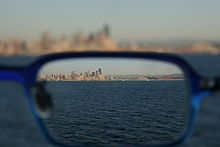
Corrective lenses are used to correct
Corrective lenses bring the image back into focus on the retina. They are made to conform to the
The most common type of corrective lens is "single vision", which has a uniform
People who need glasses to see often have corrective lens restrictions on their
Some militaries issue prescription glasses to servicemen and women. These are typically GI glasses. Many state prisons in the United States issue glasses to inmates, often in the form of clear plastic aviators.
Adjustable-focus eyeglasses might be used to replace bifocals or trifocals, or might be used to produce cheaper single-vision glasses (since they do not have to be custom-manufactured for every person).
Safety
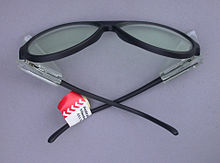
Safety glasses are worn to protect the eyes in various situations. They are made with break-proof plastic lenses to protect the eye from flying debris or other matter. Construction workers, factory workers, machinists and lab technicians are often required to wear safety glasses to shield the eyes from flying debris or hazardous splatters such as blood or chemicals. As of 2017, dentists and surgeons in Canada and other countries are required to wear safety glasses to protect against infection from patients' blood or other body fluids. There are also safety glasses for welding, which are styled like wraparound sunglasses, but with much darker lenses, for use in welding where a full-sized welding helmet is inconvenient or uncomfortable. These are often called "flash goggles" because they provide protection from welding flash. Nylon frames are usually used for protective eyewear for sports because of their lightweight and flexible properties. Unlike most regular glasses, safety glasses often include protection beside the eyes as well as in front of the eyes.
Sunglasses

Sunglasses provide more comfort and protection against bright
Light
Sunglasses may also have corrective lenses, which requires a prescription. Clip-on sunglasses or sunglass clips can be attached to another pair of glasses. Some wrap-around sunglasses are large enough to be worn over another pair of glasses. Otherwise, many people opt to wear contact lenses to correct their vision so that standard sunglasses can be used.
Mixed double-frame (Flip glasses)

The double frame uplifting glasses have one moving frame with one pair of lenses and the basic fixed frame with another pair of lenses (optional), that are connected by four-bar linkage. For example, sun lenses could be easily lifted up and down while mixed with myopia lenses that always stay on. Presbyopia lenses could be also combined and easily removed from the field of view if needed without taking off glasses. These glasses often used for driver when they went through tunnels the upper frame,sunglasses and the second frame with transparent lenses. Drivers flip the sunglasses in tunnels while driving.
3D glasses
The illusion of three dimensions on a two-dimensional surface can be created by providing each eye with different visual information. 3D glasses create the illusion of three dimensions by filtering a signal containing information for both eyes. The signal, often light reflected off a movie screen or emitted from an electronic display, is filtered so that each eye receives a slightly different image. The filters only work for the type of signal they were designed for.
Anaglyph 3D glasses have a different colored filter for each eye, typically red and blue or red and green. A polarized 3D system on the other hand uses polarized filters. Polarized 3D glasses allow for color 3D, while the red-blue lenses produce an image with distorted coloration. An active shutter 3D system uses electronic shutters. Head-mounted displays can filter the signal electronically and then transmit light directly into the viewer's eyes.
Anaglyph and polarized glasses are distributed to audiences at 3D movies. Polarized and active shutter glasses are used with many home theaters. Head-mounted displays are used by a single person, but the input signal can be shared between multiple units.
Magnification (bioptics)
Glasses can also provide magnification that is useful for people with vision impairments or specific occupational demands. An example would be bioptics or bioptic telescopes which have small telescopes mounted on, in, or behind their regular lenses. Newer designs use smaller lightweight telescopes, which can be embedded into the corrective glass and improve aesthetic appearance (mini telescopic spectacles). They may take the form of self-contained glasses that resemble goggles or binoculars, or may be attached to existing glasses.
Yellow-tinted computer/gaming glasses
Yellow-tinted glasses are a type of glasses with a minor yellow tint. They perform a slight color correction, on top of reducing eyestrain from lack of blinking. They may also be considered minor corrective non-prescription glasses.
Blue-light blocking glasses
By the end of the 2010s, eyeglasses that filter out
Long hours of computer use (not blue light) may cause eye strain.[6][9][7][10] Many eye symptoms caused by computer use will lessen after the usage of the computer is stopped.[6] Decreasing evening screen time and setting devices to night mode will improve sleep.[9][11] Several studies have shown that blue light from computers does not lead to eye diseases, including macular degeneration.[9][12][13] The total amount of light entering the eyes can be adjusted without glasses using the screen brightness settings. Similarly, the blue light can often specifically be adjusted using the "night mode" of different operating systems, which can usually be activated outside of nighttime hours.
The American Academy of Ophthalmology (AAO) does not recommend special eyewear for computer use,[6][7] although it recommends using
Frames
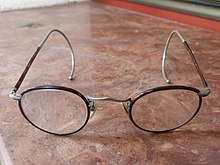
The ophthalmic frame is the part of a pair of glasses that is designed to hold the lenses in the proper position. Ophthalmic frames come in a variety of styles, sizes, materials, shapes, and colors.[16]
Parts
- pair of eye wires or rims surrounding and holding the lenses in place
- bridge which connects the two eye wires
- chassis, the combination of the eye wires and the bridge
- top bar or brow bar, a bar just above the bridge providing structural support and/or style enhancement (country/Grandpa style). The addition of a top bar makes a pair of glasses aviator eyeglasses
- pair of brows or caps, plastic or metal caps which fit over the top of the eye wires for style enhancement and to provide additional support for the lenses. The addition of brows makes a pair of glasses browline glasses
- pair of nose pads that allows a comfortable resting of the eye wires on the nose
- pair of pad arms connect the nose pads to the eye wires
- pair of temples (earpieces) on either side of the skull
- pair of temple tips at the ends of the temples
- pair of end pieces connect the eye wires via the hinges to the temples
- pair of frame-front end pieces
- pair of hinges connect the end pieces to the temples, allowing a swivel movement. Spring-loaded flex hinges are a variant that is equipped with a small spring that affords the temples a greater range of movement and does not limit them to the traditional, 90-degree angle.
Temple types
- Skull temples: bend down behind the ears, follow the contour of the skull and rest evenly against the skull
- Library temples: generally straight and do not bend down behind the ears. Hold the glasses primarily through light pressure against the side of the skull
- Convertible temples: used either as library or skull temples depending on the bent
- Riding bow temples: curve around the ear and extend down to the level of the ear lobe. Used mostly on athletic, children's, and industrial safety frames;
- Comfort cable temples: similar to the riding bow, but made from a springy cable of coiled metal, sometimes inside a plastic or silicone sleeve. The tightness of the curl can be adjusted along its whole length, allowing the back to fit the wearer's ear curve perfectly. Used for physically active wearers, children, and people with high prescriptions (heavy lenses).[17][18] See the image of 1920s frames above.
Materials
Plastic and polymer
- Cellulose acetate
- Optyl, a type of hypoallergenic material made especially for eyeglass frames. It features a type of elasticity that returns the material to its original shape.
- Cellulose propionate, a molded, durable plastic
- Nylon
Metal
Various metals and alloys may be used to make glasses, such as gold, silver, aluminum, beryllium, stainless steel, titanium, monel, and nickel titanium.
Natural material
Natural materials such as wood, bone, ivory, leather and semi-precious or precious stones may also be used.
Corrective lens shape

Corrective lenses can be produced in many different shapes from a circular lens called a lens blank. Lens blanks are cut to fit the shape of the frame that will hold them. Frame styles vary and fashion trends change over time, resulting in a multitude of lens shapes. For lower power lenses, there are few restrictions, allowing for many trendy and fashionable shapes. Higher power lenses can distort peripheral vision and may become thick and heavy if a large lens shape is used. However, if the lens is too small, it can drastically reduce the field of view.
History
Precursors


Scattered evidence exists for use of visual aid devices in Greek and Roman times, most prominently the use of an emerald by Emperor Nero as mentioned by Pliny the Elder.[20]
The use of a
There are claims that single lens magnifying glasses were being used in China during the
Robert Grosseteste's treatise De iride (On the Rainbow), written between 1220 and 1235, mentions using optics to "read the smallest letters at incredible distances".[23] A few years later in 1262, Roger Bacon is also known to have written on the magnifying properties of lenses.[24][25] The development of the first eyeglasses took place in northern Italy in the second half of the 13th century.[26]
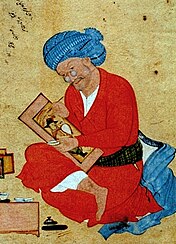
Independently of the development of optical lenses, some cultures developed "sunglasses" for eye protection, without any corrective properties.[27] For example, flat panes of
Invention

The earliest recorded comment on the use of lenses for optical purposes was made in 1268 by Roger Bacon.[29]
The first eyeglasses were estimated to have been made in Central Italy, most likely in Pisa, by about 1290: In a sermon delivered on 23 February 1306, the Dominican friar Giordano da Pisa (c. 1255–1311) wrote "It is not yet twenty years since there was found the art of making eyeglasses, which make for good vision ... And it is so short a time that this new art, never before extant, was discovered. ... I saw the one who first discovered and practiced it, and I talked to him."[30]
Giordano's colleague Friar


The earliest pictorial evidence for the use of eyeglasses is
Early frames for glasses consisted of two magnifying glasses
The world's first specialist shop for spectacles - what we might regard today as an optician - opened in Strasbourg (then Holy Roman Empire, now France) in 1466.[39]
Other claims
The 17th-century claim by
Marco Polo is mistakenly claimed to have encountered eyeglasses during his travels in China in the 13th century. However, no such evidence appears in his accounts.[42][43] Indeed, the earliest mentions of eyeglasses in China occur in the 15th century and those Chinese sources state that eyeglasses were imported.[44]

In 1907, Professor Berthold Laufer speculated, in his history of glasses, that for glasses to be mentioned in the literature of China and Europe at approximately the same time it was probable that they were not invented independently, and after ruling out the Turks, proposed India as a location.[45][c] However, Joseph Needham speculated that the mention of glasses in the Chinese manuscript Laufer used "in part" to credit the prior invention of them in Asia did not exist in older versions of that manuscript, and the reference to them in later versions was added during the Ming dynasty.[46]
In 1971, Rishi Agarwal, in an article in the
Later developments
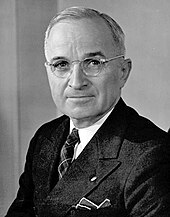
The American scientist
Over time, the construction of frames for glasses also evolved. Early eyepieces were designed to be either held in place by hand or by exerting pressure on the nose (pince-nez). Girolamo Savonarola suggested that eyepieces could be held in place by a ribbon passed over the wearer's head, this in turn secured by the weight of a hat. The modern style of glasses, held by temples passing over the ears, was developed sometime before 1727, possibly by the British optician Edward Scarlett. These designs were not immediately successful, however, and various styles with attached handles such as "scissors-glasses" and lorgnettes were also fashionable from the second half of the 18th century and into the early 19th century.
In the early 20th century, Moritz von Rohr and Zeiss (with the assistance of H. Boegehold and A. Sonnefeld[51]) developed the Zeiss Punktal spherical point-focus lenses that dominated the eyeglass lens field for many years. In 2008, Joshua Silver designed eyewear with adjustable corrective glasses. They work by using a built-in syringe to pump a silicone solution into a flexible lens.[52]
Despite the popularity of
In fashion

In the 1930s, "spectacles" were described as "medical appliances".[53] Wearing spectacles was sometimes considered socially humiliating. In the 1970s, fashionable glasses started to become available through manufacturers, and governments also recognized the demand for stylized eyewear.[53]
Graham Pullin describes how devices for disability, like glasses, have traditionally been designed to camouflage against the skin and restore ability without being visible.[53] In the past, design for disability has "been less about projecting a positive image as about trying not to project an image at all".[53] Pullin uses the example of spectacles, traditionally categorized as a medical device for "patients", and outlines how they are now described as eyewear: a fashionable accessory.[53] Much like other fashion designs and accessories, eyewear is created by designers, has reputable labels, and comes in collections, by season and designer.[53] In recent years, it has become more common for consumers to purchase eyewear with non-prescription lenses as a fashion accessory.[53]
Society and culture
Market
The market for spectacles has been characterized as having highly
There are claims that insufficiently free
The United States also prohibits the sale of glasses unless the user has a recent prescription from an optometrist or ophthalmologist, whereas in most of the world, glasses and contact lenses can be bought without needing to get a new
Redistribution
Some organizations like Lions Clubs International,[62] Unite For Sight,[63] ReSpectacle,[64] and New Eyes for the Needy provide a way to donate glasses and sunglasses to people on low incomes or no income. Unite For Sight has redistributed more than 200,000 pairs.[65]
Fashion
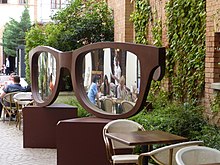
Many people require glasses for the reasons listed above. There are many shapes, colors, and materials that can be used when designing frames and lenses that can be utilized in various combinations. Oftentimes, the selection of a frame is made based on how it will affect the appearance of the wearer. Some people with good natural eyesight like to wear eyeglasses as a style accessory. In Japan, some companies ban women from wearing glasses.[66]
Personal image

For most of their history, eyeglasses were seen as unfashionable, and carried several potentially negative connotations: wearing glasses caused individuals to be stigmatized and stereotyped as pious clergymen, as those in religious vocation were the most likely to be literate and therefore the most likely to need reading glasses, elderly, or physically weak and passive.[67][68] The stigma began to fall away in the U.S. in the early 1900s when the popular Theodore Roosevelt was regularly photographed wearing eyeglasses, and in the 1910s when popular comedian Harold Lloyd wore a pair of horn-rimmed glasses as the "Glasses" character in his films.[67][68]
In the United Kingdom, wearing glasses was characterized in the nineteenth century as "a sure sign of the weakling and the mollycoddle", according to
Since then, eyeglasses have become an acceptable fashion item and often act as a key component in individuals' personal image. Musicians
Other celebrities have used glasses to differentiate themselves from the characters they play, such as
In
Common complaints
Many people who wear glasses have some common complaints. One such complaint is how glasses will naturally fog up if you wear a mask along with the glasses. This complaint became more common during the COVID-19 pandemic. Another common complaint is that bright light sources can create glare, interfering with the wearer's vision.
Styles
In the 20th century, eyeglasses came to be considered a component of fashion; as such, various different styles have come in and out of popularity. Most are still in regular use, albeit with varying degrees of frequency.
- Aviator sunglasses
- Browline glasses
- Bug-eye glasses
- Cat eye glasses
- GI glasses
- Goggles
- Horn-rimmed glasses
- Lensless glasses
- Monocle
- Pince-nez
- Rimless glasses
- Sunglasses
- Wayfarer sunglasses
- Windsor glasses
See also
Notes
- ^ Chinese judges wore dark glasses to hide their facial expressions during court proceedings.[28]
- ^ In his treatise Ad Vitellionem paralipomena [Emendations (or Supplement) to Witelo] (1604), Kepler explained how eyeglass lenses compensate for the distortions that are caused by presbyopia or myopia, so that the image is once again properly focused on the retina.[36][37]
- ^ Laufer, Berthold (1907), Geschichte der Brille (PDF), vol. 6, p. 26, retrieved 29 May 2019 Translation:
I am interested in the remarks of Prof. J. HIRSCHBERG on the "History of the Invention of Glasses" published in the last issue of this journal (Volume VI, pp. 221–223) and the subsequent discussion by Prof. GÜPPERT. The book by HIRSCHBERG mentioned therein, in which his theory should be presented in detail, has not yet become accessible to me. I, therefore, limit my criticism of it as far as possible and prefer to prove, by means of new material from Chinese literature, that the view of the original invention of spectacles in India is the greatest probability. HIRSCHBERG theory is highly unlikely, as all previous experience has shown and contradicts analogies in cultural history and in the history of inventions in particular; Crystal spectacles appear in the European Middle Ages, in India, and in China, and from the historical point of view one can suppose from the outset that these inventions did not occur independently in each of these three cultural groups, but that a historical connection is here present.
References
- ^ "Eyeglasses - All What You Need to Know", Eyewa Blog, retrieved 24 March 2020binateb
- ^ "Sunglasses not just an accessory in the Sunshine State", Sun-Sentinel.com, 12 March 2018, retrieved 10 April 2018
- ^ Loria, Kevin (21 February 2017), "Computer glasses that claim to protect your eyes from screens are selling like crazy, but they probably aren't doing you much good", Business Insider
- ^ Heiting, Gary, "Computer Eye Strain: 10 Steps For Relief", All about vision.com, retrieved 1 September 2017
- ^ "BluTech Lenses – Technology, The story behind BluTech Lenses", BluTech Lenses, archived from the original on 4 May 2015, retrieved 11 May 2015
- ^ a b c d e f Vimont, Celia (27 April 2017), Are Computer Glasses Worth It?, Reviewed by Rahul Khurana, MD, American Academy of Ophthalmology, archived from the original on 23 September 2020
- ^ a b c "Blue Light Glasses - Helpful or Just Hype?", WebMD Health News, 16 December 2019, archived from the original on 7 August 2020
- PMID 26375236
- ^ a b c Porter, Daniel (16 January 2020), Blue Light and Digital Eye Strain, Reviewed by Ninel Z Gregori, MD, American Academy of Ophthalmology, archived from the original on 28 October 2020
- ^ Iallonardo, Marisa (24 May 2020), Do blue light glasses work ?, Reviewed by Benjamin Bert, MD, Business Insider
- ^ Hazanchuk, Vered (7 May 2019), Should You Use Night Mode to Reduce Blue Light?, Reviewed by Raj K Maturi, MD, American Academy of Ophthalmology, archived from the original on 8 September 2020
- ^ Porter, Daniel (15 November 2019), Digital Devices and Your Eyes, Reviewed by Ninel Z Gregori, MD, American Academy of Ophthalmology, archived from the original on 9 August 2020
- ^ Caporuscio, Jessica (2 June 2020), "Can blue light glasses prevent damage to eyes?", MedicalNewsToday, Medically reviewed by Ann Marie Griff, O.D, archived from the original on 16 October 2020
- ^ Boyd, Kierstan (3 March 2020), Computers, Digital Devices and Eye Strain, Reviewed by James M Huffman, MD, American Academy of Ophthalmology, archived from the original on 3 October 2020
- ^ Blue blocking spectacle lenses - The College's position on blue blocking spectacle lenses, archived from the original on 19 September 2020, retrieved 24 October 2020
- ^ Optical Course, OpticalCourse.com, retrieved 7 May 2014
- ^ Cable Temples, archived from the original on 27 January 2007, retrieved 27 January 2007
- ^ "Cable conversion temple covers", www.optiboard.com
- ^ Pliny the Elder. The Natural History, Book 37, Chpt.16. John Bostock and H. T. Riley, translators. London: Taylor and Francis. 1855
- ^ "Opening our eyes to spectacles of the past".
- ^ "In the tomb of Liu Jing, the King of Guangling, a gold circle embedded with crystals was unearthed, which was the first glasses in history". 7 April 2022.
- ISBN 9780674823600From Grant's English translation of Robert Grosseteste's De Iride (On the rainbow) in Latin, p. 389: "This part [viz, from Aristotle's supposed treatise on optics] of perspective, if perfectly understood, shows us how to make nearby objects appear very small, and how to make a small object placed at a distance appear as large as we wish, so that it would be possible to read minute letters from incredible distances or count sand, seeds, blades of grass, or any minute objects."
- ^ Bacon, Roger; Burke, Robert Belle, trans. (1962) The Opus Majus of Roger Bacon (New York: Russell & Russell, Inc.) vol. 2. Part 5, Ch. IV, p. 582. From p. 582: "For we can so shape transparent bodies, and arrange them in such a way with respect to our sight and objects of vision, that the rays will be refracted and bent in any direction we desire, and under any angle, we wish we shall see the object near or at a distance. Thus from an incredible distance we might read the smallest letters and number grains of dust and sand ..."
- ^ ...Optics Highlights: II. Spectacles, University of Maryland, Department of Electrical & Computer Engineering, archived from the original on 23 September 2015, retrieved 1 September 2007
- PMID 9574655
- ^ Ament, Phil (4 December 2006), "Sunglasses History – The Invention of Sunglasses", The Great Idea Finder, Vaunt Design Group, archived from the original on 3 July 2007, retrieved 28 June 2007
- ^ Needham 1962, p. 121.
- ^ "Eyeglasses | optics", Encyclopedia Britannica, retrieved 18 February 2021
- ^ Ilardi 2007, p. 5.
- ^ Ilardi 2007, p. 6.
- ^ a b c Rasmussen, Seth C. (2008), "Advances in 13th Century Glass Manufacturing and Their Effect on Chemical Progress" (PDF), Bulletin for the History of Chemistry, vol. 33, no. 1, pp. 29–34, retrieved 18 October 2021
- ^ Ilardi 2007, p. 9.
- ^ Petrarch (Franciscus Petrarca) mentions eyeglasses in his Epistola ad Posteros (Letter to Posterity): Petrarca, Francisci (1859), Fracassetti, Joseph (ed.), Epistolae de Rebus Familiaribus et Variae ... (in Latin), vol. 1, Florence, Italy: Felice Le Monnier, pp. 1–2,
... colore vivido inter candidum et subnigrum, vivacibus oculis et visu per longum tempus acerrimo, qui preter spem supra sexagesimum etatis annum me destituit, ut indignanti michi ad ocularium confugiendum esset auxilium.
- ^ English translation: Petrarch (1914), Robinson, James Harvey; Rolfe, Henry Winchester (eds.), Petrarch: The First Modern Scholar and Man of Letters (2nd ed.), New York: G. P. Putnam's Sons, p. 60,
I was possessed of a clear complexion, between light and dark, lively eyes, and for long years a keen vision, which however deserted me, contrary to my hopes, after I reached my sixtieth birthday, and forced me, to my great annoyance, to resort to glasses.
- ^ Ilardi 2007, p. 244.
- ISBN 9780486668468
- ^ "Rivet spectacles", www.college-optometrists.org, The College of Optometrists, 2015, retrieved 28 February 2015
- ^ a b Harford, Tim (20 November 2019), "Why do billions of people still not have glasses?", BBC News, retrieved 21 November 2019
- PMID 13306950
- ^ Ilardi 2007, pp. 13–18.
- ^ Needham 1962, p. 119, footnote c.
- ^ Hirschberg, Julius (1911), "Geschichte der Augenheilkunde" [History of Ophthalmology], in Graef, Alfred K; Saemisch, Theodor (eds.), Handbuch der gesamten Augenheilkunde [Handbook of all ophthalmology], Handbuch der Augenheilkunde, vol. 13, Leipzig, Germany: Wilhelm Engelmann, pp. 265 ff Section Geschichte der Brillen (History of Eyeglasses) From pp. 266–267 (translated): "3. Do the Europeans have the Chinese to thank for eyeglasses? ... Messrs. Scrini and Fortin in Paris have asserted this recently with the words: 'One knows, on the other hand, that when Marco Polo went to China, he learned that for a very long time already, the inhabitants had been using eyeglasses.' This assertion lacked any substantiation. So I have closely perused the German translation of 'the books of Marco Polo' (2nd ed., Leipzig 1855) once again as well as carefully compared [that book] to the original text (the book of Marco Polo by Pauthier, Paris 1865, 2 volumes): not a syllable about eyeglasses in China is found therein. Our highly esteemed Sinologist, Prof. Graube, had the kindness to peruse also the English edition (by Yule, London 1875), with the same negative result. Thus the sentence of Messrs. Scrini and Fortin is to be crossed out; this error may not be the only one to have infiltrated the literature."
- ^ Needham 1962, p. 119.
- ^ Laufer, Berthold (1907). "Geschichte der Brille" [History of eyeglasses]. Mitteilungen zur Geschichte der Medizin und der Naturwissenschaften [Communications on the History of Medicine and the Sciences], 6 (4) : 379–385.
- ^ Science and Civilization in China Vol 4.1 (PDF), pp. 118–119, archived from the original (PDF) on 23 August 2016, retrieved 3 May 2014
- PMID 4927695.
- ^ Renaissance Vision from Spectacles to Telescopes, Vincent Ilardi, American Philosophical Society 2007 pages 118–125
- ^ The 'Inventor' of Bifocals?, The College of Optometrists, archived from the original on 13 June 2011
- ^ Bruen, Robert, "Sir George Biddell Airy", The Lucasian Chair of Mathematics at Cambridge University, Robert Bruen, archived from the original on 25 January 2021, retrieved 1 January 2014
- ^ Eyeglass Lenses and Visual Aids from Industrial Production, Zeiss, retrieved 2 September 2007
- ^ Whiteman, Honor (12 November 2015), "Self-adjustable eyeglasses: how one man's vision is helping others to see better", Medical News Today, Red Ventures, retrieved 25 October 2021
- ^ ISBN 9780262162555
- S2CID 154878241
- ^ Hutchinson, Dr Emma; Hutchinson, University of Victoria and; Emma (2017), "8.1 Monopoly", Principles of Microeconomics, retrieved 6 May 2021
- ^ Swanson, Ana, "Meet the Four-Eyed, Eight-Tentacled Monopoly That is Making Your Glasses So Expensive", Forbes, retrieved 6 May 2021
- ^ "Is Luxottica A Monopoly?", Financhill, 19 January 2021, retrieved 6 May 2021
- ^ "Does Luxottica Own 80% of the Eyeglass Industry?", snopes.com, 20 September 2016
- ^ "Why are glasses so expensive?", CBS News, 7 October 2012
- ^ "Sticker shock: Why are glasses so expensive?", 60 Minutes, CBS News, 7 October 2012, retrieved 19 October 2012
- ^ a b c Mounk, Yascha (27 November 2019). "The Great American Eye-Exam Scam". The Atlantic. Retrieved 22 July 2023.
- ^ Lions Eyeglasses Recycling Facts, Lions Clubs International, retrieved 20 August 2008
- ^ Donate Eyeglasses and Sunglasses, Unite For Sight, archived from the original on 20 August 2008, retrieved 20 August 2008
- ^ The world's online database of high quality used glasses, ReSpectacle, retrieved 11 July 2017
- ^ "Brick Award Winner: Jennifer Staple", People: do something, HowStuffWorks, 20 February 2007, retrieved 20 August 2008
- ^ Steger, Isabelle (7 November 2019), ""It gives a cold impression": Why Japanese companies ban female staff from wearing glasses", Quartz (publication), retrieved 7 November 2019
- ^ a b "Understanding Three-Piece Mounting", Eyewear, Seiko, archived from the original on 28 October 2008
- ^ a b Lloyd, Annette (1996), The Fashion of Harold Lloyd
- ^ a b "The Spin | Tim Killick, the bespectacled rogue who got clattered for 34 in an over", the Guardian, 7 July 2020
- ISBN 0-06-013311-2.
- ^ Sykes, Eric (31 December 2004), "Comedy Great", News, BBC
- ^ Archived at Ghostarchive and the Wayback Machine: "Whacky NBA Playoff Fashion!", YouTube, retrieved 26 June 2012
- ^ Cacciola, Scott (14 June 2012), "NBA Finals: LeBron James, Dwyane Wade and Other Fashion Plates of the NBA Make Specs of Themselves", The Wall Street Journal (online ed.), retrieved 26 June 2012
- S2CID 150204262
General bibliography
- Ilardi, Vincent (2007), Renaissance Vision from Spectacles to Telescopes, Philadelphia, Pennsylvania: American Philosophical Society, ISBN 9780871692597.
- Needham, Joseph (1962), "Part 1", Science & Civilisation in China, vol. IV, Cambridge, England: Cambridge University Press, ISBN 9780521058025.
External links
- Spectacles Gallery at the British Optical Association Museum
- "Spectacles", The Medieval Technology, NYU, archived from the original on 16 October 2015, retrieved 15 June 2009.
- "Are Your Eyes Right", Popular Science (article), February 1944, archived from the original on 2 June 2013, retrieved 23 August 2010, on eyes and how eyeglasses correct vision (page 120).
- "Common Spectacles Styles before, during and after the Civil War" (2012 article) via the Internet Archive; Antique Eyeglasses in America.
